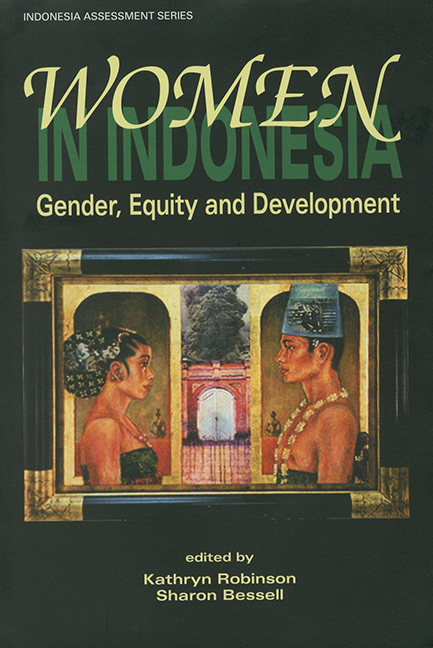Book contents
- Frontmatter
- Contents
- Tables
- Figures
- Contributors
- Acknowledgments
- Glossary
- Prologue
- 1 Introduction to the Issues
- 2 The Mega Factor in Indonesian Politics: A New President or a New Kind of Presidency?
- 3 The Downfall of President Abdurrahman Wahid: A Return to Authoritarianism?
- 4 The Year in Review: From Blind Man's Bluff to Mega Expectations
- 5 Further Comments on the Economy, with a Gender Perspective
- 6 Institution Building: An Effort to Improve Indonesian Women's Role and Status
- Commentary
- 7 Feminism in Indonesia in an International Context
- 8 Gay and Lesbi Subjectivities, National Belonging and the New Indonesia
- 9 And the Winner Is … Indonesian Women in Public Life
- 10 Indonesian Women Artists: Transcending Compliance
- 11 Literature, Mythology and Regime Change: Some Observations on Recent Indonesian Women's Writing
- 12 Women and the Labour Market during and after the Crisis
- 13 Women's International Labour Migration
- 14 Customary Institutions, Syariah Law and the Marginalisation of Indonesian Women
- 15 Women's Grassroots Movements in Indonesia: A Case Study of the PKK and Islamic Women's Organisations
- 16 Women's Activism against Violence in South Sulawesi
- 17 Gender Mainstreaming and Sex-disaggregated Data
- 18 The Changing Indonesian Household
- 19 Women, Family Planning and Decentralisation: New Variations on Old Themes
- 20 Men, Women and Community Development in East Nusa Tenggara
- References
- Index
- INDONESIA ASSESSMENT SERIES
13 - Women's International Labour Migration
Published online by Cambridge University Press: 21 October 2015
- Frontmatter
- Contents
- Tables
- Figures
- Contributors
- Acknowledgments
- Glossary
- Prologue
- 1 Introduction to the Issues
- 2 The Mega Factor in Indonesian Politics: A New President or a New Kind of Presidency?
- 3 The Downfall of President Abdurrahman Wahid: A Return to Authoritarianism?
- 4 The Year in Review: From Blind Man's Bluff to Mega Expectations
- 5 Further Comments on the Economy, with a Gender Perspective
- 6 Institution Building: An Effort to Improve Indonesian Women's Role and Status
- Commentary
- 7 Feminism in Indonesia in an International Context
- 8 Gay and Lesbi Subjectivities, National Belonging and the New Indonesia
- 9 And the Winner Is … Indonesian Women in Public Life
- 10 Indonesian Women Artists: Transcending Compliance
- 11 Literature, Mythology and Regime Change: Some Observations on Recent Indonesian Women's Writing
- 12 Women and the Labour Market during and after the Crisis
- 13 Women's International Labour Migration
- 14 Customary Institutions, Syariah Law and the Marginalisation of Indonesian Women
- 15 Women's Grassroots Movements in Indonesia: A Case Study of the PKK and Islamic Women's Organisations
- 16 Women's Activism against Violence in South Sulawesi
- 17 Gender Mainstreaming and Sex-disaggregated Data
- 18 The Changing Indonesian Household
- 19 Women, Family Planning and Decentralisation: New Variations on Old Themes
- 20 Men, Women and Community Development in East Nusa Tenggara
- References
- Index
- INDONESIA ASSESSMENT SERIES
Summary
The involvement of Indonesian women in international labour migration has increased substantially over the last two decades. This chapter traces the movement of women – both legal and undocumented – to work overseas. It discusses the processes of recruitment, training and deployment, and the reasons why women choose to work abroad. There is a focus on the impact on the women themselves, and on the families and communities they leave behind. It is clear that while for many women working abroad is a negative and disempowering experience, others gain from it. All signs indicate that women's migration will increase. This chapter examines existing policies and practices on the protection of international women labour migrants from Indonesia and makes a number of recommendations for urgent consideration.
TRENDS IN LABOUR MIGRATION OF WOMEN: DOCUMENTED MIGRATION
Indonesian female labour migration can be divided into that which passes through official channels and that which does not. Table 13.1 shows the annual changes in the numbers of Indonesian overseas contract workers (OCWs) that have occurred over the last quarter-century. There is a clear pattern of growth in the numbers of workers deployed overseas, most of whom are women.
The apparent downturn in 1995/96 was due to the exclusion of some workers from the data, while the exceptional figures for 1996/97 include a large number of workers already in Malaysia who received an amnesty (Hugo 2000). Bearing these special circumstances in mind, it is apparent that there was an upturn in deployment of workers following the onset of the Asian economic crisis in mid-1997 (Romdiarti, Handayani and Rahayu 1998: 23). Indeed, the number of official OCWs sent overseas between the onset of the crisis and the end of 1999 was greater than all those sent under the country's first five five-year plans (Repelita I–V).
The dominance of women in the official outflow of labour migrants has been consistent over the last two decades. Of the OCWs deployed under Repelita VI (1994–99), 1,021,103 were women and 440,133 were men. Three-quarters of Indonesian labour migrants went to two nations: Malaysia (38.1 per cent) and Saudi Arabia (37.7 per cent). In both cases women migrants outnumbered men, only slightly in the case of Malaysia but by twelve to one in the case of Saudi Arabia.
- Type
- Chapter
- Information
- Women in IndonesiaGender, Equity and Development, pp. 158 - 178Publisher: ISEAS–Yusof Ishak InstitutePrint publication year: 2002



